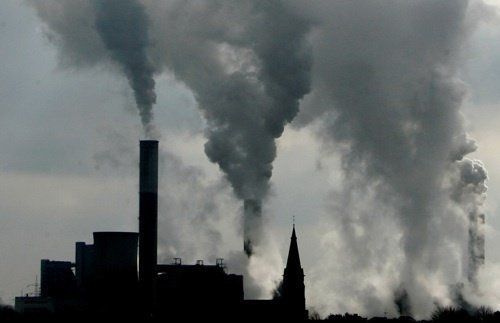
The U.S. Environmental Protection Agency (EPA) held hearings in Chicago's Ralph H. Metcalfe Federal Building on Thursday in which members of the public were invited to express their opinions about (but more often than not, expressed their adulation over) the proposed carbon pollution standards for new power plants. With moments of compelling commentary, the forum provided a pressing reminder that there are real victims of our choice to pollute or put up with pollution, and in many instances those victims are from low-income areas.
Some of the comments dealt with the nuts and bolts of the regulation. The EPA would restrict emissions to 1,000 pounds of carbon dioxide per megawatt hour, compared to the average 1,800 pounds per megawatt hour that power plants emit. One woman opposed to the proposed carbon pollution standards for new power plants cited a Fox News report and highlighted the potential for the regulation to impact electricity bills. (Plenty of economists would disagree with her.) Seated next to her at the front of the room waiting to speak was Lawrence Lemon, a man from Columbus, Ohio, whose poignant story of how air pollution impacted his family would make the woman's claims sound insouciant.
Lemon, a representative of the Ohio chapter of the NAACP's National Climate Justice Initiative, lost his mother in 2006 to a combination of Jo-1 syndrome, a rare autoimmune disorder whose etiology is unknown, and interstitial lung disease, which is connected to environmental causes. He talked movingly about her struggles, including depending on an oxygen machine and spending her last month of life in a medically induced coma. He believes her work near an incinerator in the poverty stricken west side of Columbus may have contributed to her disorders.
Afterward he spoke on the impact of coal power plants: "A large majority of these plants are around the communities where African Americans live -- and low income minorities. Not only is that home, but it's also where you worship and go to school."
Jocelyn Travis, another member of the NAACP in Ohio, spoke to EPA officials about the high rates of asthma among people of color in Cleveland, her home city. Indeed, the asthma rates there for all groups are well out of proportion with national averages, but they are especially bad for Hispanic children. Later she recounted the poor urban planning that went into building many coal power plants and other large operations that emit toxic chemicals through pollution. Sometimes they were founded near unsuspecting neighborhoods. Yet she remembers how city officials who might have known better watched and did nothing as poor people built communities around dangerous plants.
One positive Travis saw is that in the future, " they probably won't even build around residents," due to the increasing scrutiny on power plants and the new limits." Lemon was more insistent, saying, "We're not going to let plants be built in these communities anymore."
From power plants to refineries, minorities and people of less resources are more likely to be impacted by dirty energy and pollution. Sixty-eight percent of African-Americans live within 30 miles of a coal plant and African-Americans seek hospital treatment for asthma at three times the rate of whites.
Yet as the Chicago Tribune reported on Thursday, the EPA is chipping away at the entrenched clout of polluters. Recently the EPA ordered BP to reduce flaring at its Whiting, Indiana, refinery by 90 percent, which would result in 4,000 tons less of hazardous chemicals being released into the air. The agreement also would result in 108,000 tons less of greenhouse gas emissions and less chemicals that cause smog. The pollution in Whiting reaches nearby communities on the South Side of Chicago.
"A lot of these refineries are in disadvantaged areas," George Czerniak, the EPA's regional chief of air enforcement, told Tribune reporter Michael Hawthorne. "We need to keep an eye on them."
While the EPA does its job fighting for those most impacted by pollution, it is helpful to hear the stories of those who are suffering its all too tragic costs. This puts a human touch on what are often technical tales of megawatt hours and tons of gas. Hearings such as the one in Chicago (and the simultaneous hearing that took place in Washington, D.C.) help bring those stories out.
To tell your own story about how dirty energy and practices have impacted you, and why it is important to safeguard the most vulnerable from future health problems, submit written comments on the proposed rule. They will be accepted until June 25, 2012 at the EPA's web site.
